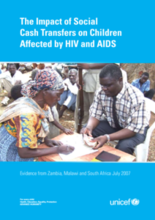Do social cash transfer schemes in countries with high HIV and AIDS prevalence that target a broad spectrum of poor or extremely poor households, but do not explicitly target HIV and AIDS affected persons or households, have a significant AIDS mitigation impact? The study attempts to answer this question by presenting and analysing literature on the five biggest social cash transfer schemes in South Africa and data from pilot schemes in Zambia and Malawi. The analysis tries to establish the degree to which the different schemes reach HIV and AIDS affected households and in which ways the beneficiary households and the children living in these households benefit from the schemes. By comparing the different schemes the study identifies the main factors that determine both the share of HIV and AIDS affected households reached and the impact achieved.
Appropriately designed social cash transfer schemes in low income African countries with high HIV and AIDS prevalence – that do not use HIV and AIDS as a targeting criterion – can reach approximately 80 per cent of those HIV and AIDS affected households that urgently require social welfare interventions because they are ultra poor and labour constrained. As approximately 60 per cent of the members of these households are children, social cash transfer schemes have a high mitigation impact on HIV and AIDS affected children. This high impact is achieved by those schemes that:
- focus on ultra poor households, which are at the same time labour constrained
- have effective targeting criteria and procedures that reduce the exclusion error to less than 20 percent
- provide transfers regularly, reliably and at a level sufficient to meet the most essential needs of all household members
- link the beneficiaries to health and welfare services like ART, home based care and psychosocial counselling
- are a component of a social protection policy and programme that complements social cash transfers for ultra poor labour constrained households with productivity and employment oriented schemes that target ultra poor households with adult members who are fit for work.
Schemes that fulfil these criteria can be qualified as effective AIDS mitigation schemes. They are inclusive because they reach the worst-off cases of most vulnerable groups (e.g. old, disabled and chronically ill people and OVC).
In view of the limited resources available for social protection, the limited implementation capacities in low income countries and the stigma associated with using HIV and AIDS as a targeting criterion, it is not recommended to establish additional schemes that exclusively target HIV and AIDS affected households or HIV and AIDS affected children.
One exception to this general recommendation could be the case of households with one or more members that are on ART. These households have substantial additional expenses (compared to other HIV and AIDS affected households), because the ART patients have specific nutritional, health care and logistical needs (especially in rural areas). It is recommended to explore the feasibility of a scheme that would facilitate that the hospitals that provide ART also provide a specific cash transfer to ART patients for meeting these costs. This could be done as a universal transfer to all ART patients regardless if their households receive social cash transfers or not.
©UNICEF

